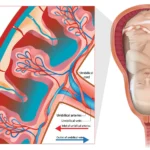Cervical effacement is the process that leads to the thinning and stretching of the cervix. This is your body’s way of getting ready for the upcoming labor and delivery.
The cervix is a long, tube-like structure that connects the uterus to the birth canal. The cervix stays closed throughout the pregnancy and is firm to the touch. First, it begins to soften and thin out as you approach 37 weeks, and then it prepares to open up when labor is near.
What is cervical effacement?
In late pregnancy, the baby moves down low into the pelvis. This is visible outside, too, as your belly appears too low. When this happens, the baby’s head adds pressure on the cervix. This makes the cervix loosen up and start stretching. This is when effacement is said to take place. Cervical effacement usually happens when you are closer to your due date.

During pregnancy, the cervix remains sealed by a mucus plug at its opening. The tissue is formed when the mucus plug is released. The mucus plug is a thick, transparent blob of mucus. The passage of mucus plugs will prevent you from noticing them. This is a bloody show and occasionally has a reddish tint from minimal amounts of blood. Your labor is near when you experience a bloody or mucus plug discharge. It may begin soon or take a few more weeks.
The timing of effacement and dilation of the cervix differs from woman to woman. In some pregnancies, effacement can take a few weeks and happen at a slow pace. First-time expecting moms may not feel dilated after the second part of their labor. Your doctor or midwife may use your fingers to feel for effacement as your due date approaches. Effacement of the cervix is usually measured in percentages. When the cervix thins out, the effacement can occur.
Dilation
The cervix also needs to dilate, apart from effacement, for the baby to pass through the birth canal. The shortened and stretched-out cervix worsens when your labor begins because of uterine contractions. This helps the baby to position itself and be ready for birth. The cervix has become dilated. You need 10 cm to start pushing.






